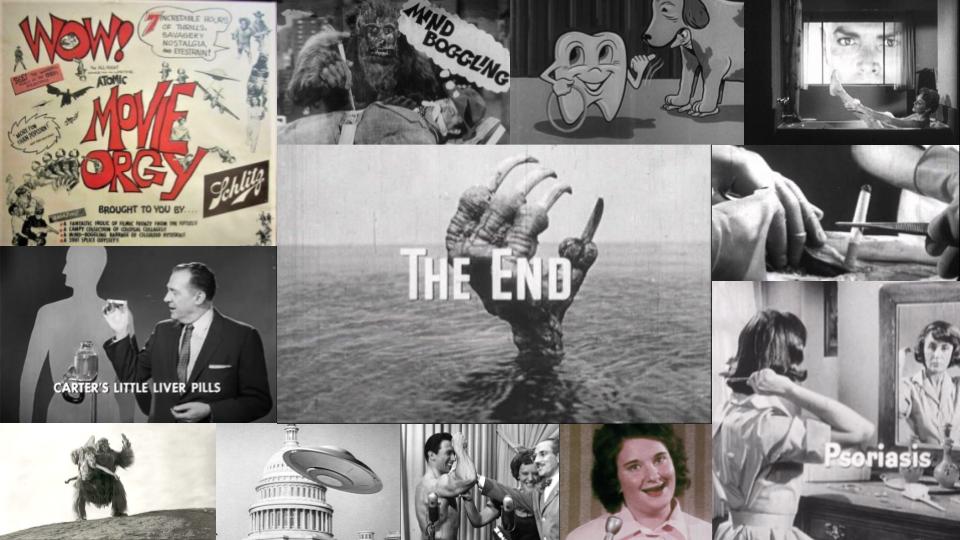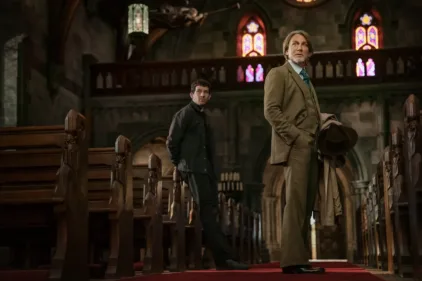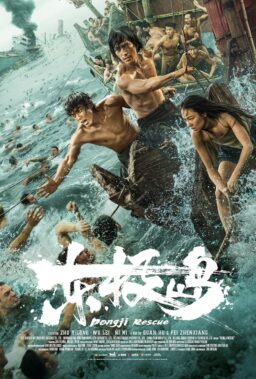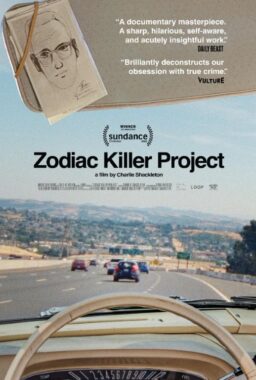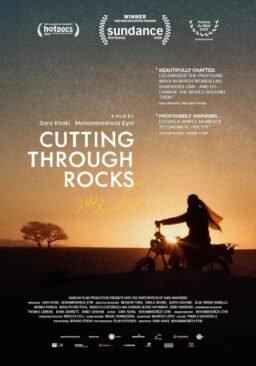Joe Dante’s first film came in at around seven hours long. That might be a record for a first feature, but some might say “The Movie Orgy” (1968) hardly qualifies as a real film. I disagree. While Dante and co-director Jon Davison might not have been on any sets or called “action!” on any scene in the film, it still exists as a kind of window into the past via a parade of randomly spliced clips from movies and TV shows of the ‘40s, ‘50s and ‘60s and is funnier than most films made today. Categorized as a documentary on IMDb, it is often thought of as the first ever found footage “mash-up” video. More than that, though, “The Movie Orgy” remains today a purely cinematic experience unlike any other.
That seven-hour cut no longer exists. “The Movie Orgy” now has a running time of four hours and thirty-five minutes, has been fully restored, color corrected, and can now be legitimately booked through the American Genre Film Archive for any theater that wants it, providing they don’t charge admission. You won’t find it on any streaming service or physical media. The only way to see “The Movie Orgy” is by being lucky enough to learn of a screening of it in your area. My advice to indie theater owners and local film societies: Book it! The people who show up will thank you. Those of you who want to see it should obviously email these wonderful organizations and businesses and stir up demand.
So, what exactly is “The Movie Orgy”? Imagine taking five or six sci-fi/monster movies and pulpy melodramas, randomly cutting between them in no particular order, and interrupting them with cheezy television commercials of that same era, as well as old game shows, musical performances, deranged children’s TV shows, movie trailers, cartoons, Nixon speeches, and television westerns. Just as you’re getting used to a scene playing out from “Attack of the 50 ft. Woman,” Dante and Davison pull the rug out from under you and cut to a laxative commercial. From there, you get taken to an old Groucho Marx bit, followed by a clip from an insufferable and creepy show called “Andy’s Gang” (this always gets the biggest laugh), then onto a different film (could be “Speed Crazy” or “The Beginning of the End” or something along those lines), then something from “The Lone Ranger” TV show. And so on, for four and a half hours. It is a fast-paced editing exercise in pop culture absurdism that has to be seen with an audience to be truly appreciated. This clip gives an idea of what this looks like.
“The Movie Orgy” was a huge hit on college campuses back in the late ‘60s and early ‘70s, so much so that even the Schlitz beer company wanted in on the action and ended up sponsoring screenings. Dante and Davison kept changing the film and trying new things with it until it became too much of a burden to lug all those reels around. They whittled it down to a far more manageable 275-minute version that has been popping up in screenings for the past 15 or so years via a video version that Dante owns.
“You gotta remember the reason it was so hard to see is there was only one print,” Dante says. “This was all actual footage we found and spliced together. It was a bear to actually project because all the film stocks were different. Every time there’d be a splice, you’d have to readjust the focus and adjust the sound.”
Today, the film exists on a far more manageable DCP and can be enjoyed just as much. I happened to catch a screening of it a few weeks ago at a venue that would prefer to remain anonymous (I’ll say the north side of Chicago) and have seen it three times in my life. Part of the experience is an endurance test. As Dante has said, “It’s made to be walked out on. If you want to go smoke a cigarette, get some fresh air, you can, and you won’t miss anything.” When the film was over, everyone who showed up was still sitting in the theater, grateful for having stayed and being treated to a most unique film experience.
We originally spoke with Joe Dante about “The Movie Orgy” in 2016, but we thought we’d catch up with him now that it’s more readily available.

A conversation with Joe Dante
The thing that gave us the idea to do “The Movie Orgy” was the reissue of the 1943 “Batman” serial. To promote the new TV show, it was re-released to art theaters, so that all 15 chapters could be watched one after another. And after about five hours of this, your brain started to rot. And after watching all the cheats they did at the beginnings and ends of the chapters where Batman’s gonna be run over by a train, and then “Tune in, see what happens.” And then you go next week, and you see an extra shot where Batman rolls out away from the train. Well, you weren’t supposed to remember that you didn’t see that shot last week.
So, when you saw them all together, it was just so obvious what a cheat this was … It was very popular, and I thought, “Well, that’s not the only serial that was made. Let’s get another serial and run it at the Philadelphia College of Art,” which is where I was going to school at the time. So, we got “The Phantom Creeps,” which is a 1939 Bela Lugosi serial, which has as many funny things in it, and we essentially created the template for “The Movie Orgy” by interspersing that with some of the extra material that we had, cartoons and trailers. That’s what led it to running at NYU, where Jon was going. Then we ran it at Columbia University. By the time we ran it in several places, then the Schlitz people showed up.
What got cut from the seven-hour version?
I miss some of the movies we had in it. We used to have “I Was A Teenage Werewolf,” “Return of the Ape Man,” some really funny stuff. It is what it is now. It has a lot of stuff that dates all the way back to the very beginning, but some of the stuff was different.
I’m trying to picture the editing room you had back in the day with reels everywhere. Do you have an image in your head about that time period?
Well, it’s all edited on 16mm, spliced, and taped. It was very awkward because we had a lot of film. Every time we found something new, we had to splice it in and run it to see if it worked. It was very time-consuming. The reason we did this is because, at that time, in the late ‘60s, there was this whole idea of “camp.” Susan Sontag popularized this phrase meaning it was stuff people were laughing at that was supposed to be taken seriously.

I wanted to ask you about that because the film came out in 1968, with many of the films and TV shows featured in it that were made not too long before that. I’m guessing that throughout the late ‘60s and into the ‘70s, the film must’ve played like a nostalgia reel for its young viewers, but today it plays like an absurdist window into the past. Have you seen a vast difference in the response to the film over the years and different generations seeing it?
The only difference I’ve seen is the popularity of the thing, originally, was based on the fact that so much stuff in it was stuff from their childhoods that they hadn’t seen since they were kids, and it was now unlocked in their brains. Oh my god, “Tales of the Texas Ranger,” I used to watch that when I was seven. Or Froggy the Gremlin, all that stuff that resonated with people because it was something they remembered. Today, most of that stuff is just … weird. I remember we ran it at the Museum of Modern Art, and my niece, who was about 14 years old and was with one of her friends, and at about the hour-and-a-half mark, I saw her and I asked, “Is this not working for you?” and she said, “I don’t understand any of this.” [laughs] And I imagine there’s a large contingent of people who would look at this thing today and say, “I don’t know what the hell they’re trying to do here.” It is an early YouTube mashup kind of thing.
Since you’ve always had a fondness for monster movies and sci-fi B-movies, does it ever bother you when today’s audiences laugh at some of the stuff from the clips in the film? I know you’re not a fan of MST3K and audiences who go to old movies just to snicker at them, but “The Movie Orgy” seems set up in a way where laughter is permitted. Do you feel that way about it? Are you ever conflicted about it?
No, I’m never conflicted about it. I always felt “The Movie Orgy” was a celebration of this stuff as opposed to simply making fun of it. If you’re just going to make fun of something for five hours, that’s kinda nihilistic. The idea is there’s a lot of humor involved in the foibles of the things that we always venerated when we were kids and how it’s changed when we get older and politically how things changed, things like the Defenders of America cards, how they look today as opposed to how they looked then. So, it’s a time capsule. There are some slow stretches in it, mostly during “College Confidential.” Still, I think it’s a very entertaining way to spend five hours.

I feel like now is the perfect time for “The Movie Orgy” because our attention spans are shorter than ever. The audience I saw it with was into the idea that you could just interrupt a slow stretch with a random toy commercial.
Well, it’s the juxtaposition that actually makes it work. Most of the things are funny because of the way they’re edited. I’ve always been amazed that people stay during the whole thing. We would always tell them upfront: you can go out, get a pizza, come back, and you won’t have missed anything. But there’s something about watching this thing and not knowing what’s going to come up next, that if you leave, you won’t get to see whatever it is that’s coming up next. That might be the thing you like the best.
I think there are pockets of film nerds like me who want to be able to say they made it all the way through “The Movie Orgy.”
Well, it’s a bonding experience. I mean, I remember when I saw “Showgirls” and when I left, in the lobby, everyone had felt like they had just survived some sort of catastrophe together. One of the things I told the Genre Archive guys is, “The reason I’m letting you do this is because everybody keeps asking me when I’m going to put this on video, when I’m going to put it on DVD.” I’m never doing that, not only because I don’t own half of it but also that’s not the way it works. It doesn’t exist unless there’s an audience. The extra level of the movie is you’re seeing it with an audience, and you’re getting an audience response. It’s not the same thing if you’re watching it on video. It’s the fact that you’re having a communal experience. To me, it’s a great example of why people should go to the movies instead of watching them at home.
I found that with every audience I’ve sat with, it takes them about 20 minutes to get acclimated.
Well, so much of the first 20 minutes is “Attack of the 50 Ft. Woman,” which is a pretty turgid movie. [laughs]

(SPOILER question) At every screening I’ve seen, the audience never seems to trust when the film is over because of all the false endings. Did you and Jon always know how it would end?
No, we always felt that if the film leader played out, then people would realize that’s the film leader. That is the end of the film. I always felt that “Happy Trails” should have played without an image, that it should’ve been exit music, but we couldn’t do that. There are many things I obviously would’ve changed had I been working on it, but when the American Genre Film Archive said they wanted to distribute it, I just figured I’m not going to do anything to it. I’m just going to give it to them and say, “This is it.”
Let’s talk about the restoration process of this. I know it’s an assemblage of 16mm clips and not the original source material. It looks like some of the sound flaws have been cleaned up a little bit. There’s not much of a lag in the syncing.
Well, one of the things you have to deal with in editing film, 16mm film particularly, is that the sound and the image are not in the same place. The sound is in advance. So, if you make a splice, the sound carries over into the next cut. So, sometimes that works in your favor, where you get a really funny line over a picture that was never meant to be. So, to solve that problem, we would take the blooping tape and bloop out some of the sounds and bloop out some of the pictures so that it would go black. It was the only way we could keep things in sync. When we went to video, we were able to edit almost all that stuff out. So, now it actually flows better than it did when it was on film.
And as I said, when it was on film, it was out of focus, and there were scratches. For some of it, we bought different prints and replaced the material so that there weren’t as many rainbow scratches during it. Some of the stuff, I don’t know where you’d go to find it again, like that fake commercial where the two girls take their clothes off. Some of that stuff is just gold, like the Bufferin commercials, which are actual real commercials. Someone must’ve thought they were a good idea. They ran them once and then retired them. I happened to get a hold of the 16mm prints and put them in “The Movie Orgy.” Otherwise, nobody would’ve remembered they existed.
With the American Film Genre Archive having it available, do you feel this is the last chapter in the saga of “The Movie Orgy”?
Oh, I think so. I think it’s amazing that it’s had such a long run. This would be sitting in my garage rotting, honestly, if these guys hadn’t come along. We’ve run it on various occasions, but it has always needed an introduction. So, I actually taped an introduction and told them, “You can use this if people want to book this. This introduction will explain to people what they’re going to see.” But maybe on its own, maybe people find it on their own, and it is what it is, and it relates to them or not.
One film of yours that instantly comes to mind when I connect “The Movie Orgy” with your later work is the last half-hour of “Explorers,” with all the TV sets in the spaceship running off clip after clip of American television from the ‘50s and ‘60s. Did you use what you knew from “The Movie Orgy” to put that sequence together?
Well, the thing about “Explorers” was when I got the first script, there wasn’t any of that kind of thing in there. The kids meet the aliens, they play baseball, and then they go home. That didn’t seem like enough for me, so we came up with this other concept that the aliens had been watching TV and had learned our language by watching American television. They think we’re like what they see on television. So, it obviously was informed quite a bit by “The Movie Orgy,” but I’ve not only used bits of “The Movie Orgy” in my other films, like literal cuts, I’ve stolen from it shamelessly. The Art Linklater bit is in “Matinee” because it was a real thing that was on TV at that time. So, it’s been very formative in my career, the fact that that was my first movie.
Currently, Joe Dante serves as a consulting producer on Max’s “Gremlins: Secrets of the Mogwai.” You can also hear Dante weekly on the podcast “The Movies That Made Me” with him and Josh Olson. Go to https://trailersfromhell.com/ to learn more.

